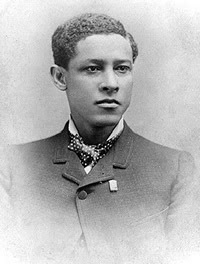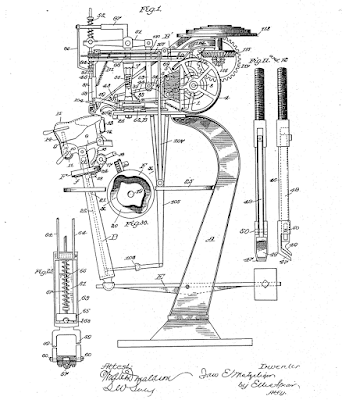 |
| Jan Ernst Matzeliger |
1852 – 1889
Who Was He?
Jan Ernst Matzeliger was born in 1852 on a coffee plantation in Dutch Guiana. His father owned the land and his mother was enslaved.
At the age of 10, he was apprenticed in the colonial ship works in Paramaribo.
While working in the shipyards, he showed early skill and a deft hand with mechanical things.
 |
| Merchant Ship |
At 19 he left Dutch Guiana and worked as a mechanic for the Dutch East Indies Company on a merchant ship.
By 1877 he had mastered English sufficiently to get off the ship in Philadelphia and stay put.
While he was in Philly, he got into the shoe trade.
The Shoe Trade
The making of shoes is big business. It always has been. Since mankind decided to be shod, he needed someone to make shoes. In the old days, before the mechanization of the shoe industry, shoemakers were called cordwainers. A cobbler did not make shoes. They repaired them. In fact, cobblers were forbidden to make shoes because they were considered a lesser skilled person.
 |
| A Shoe Last |
The process of making shoes used to be an art form or handicraft. First, the cordwainer had to make a last. The last is the mold that tells the shoemaker what shape and size shoe to make. Cordwainers kept the lasts and if you needed a new pair of shoes, you could go and see the local cordwainer.
Up until the advent of the industrial age, shoes were made by hand. Slowly over the course of the 1800s more and more mechanization was added to the process. People were using sewing machines instead of doing all the intricate hand stitching, and they used machines to shape the shoes.
There was one last bit of mechanization that had not yet arrived. The upper shoe had to be attached to the sole. If this is not done properly, it will result in an ill fitting shoe that will not last long.
When Jan Matzeliger joined the shoe trade, the upper shoe and the sole were still being sewn together by hand.
That meant that every single person in the shoe trade could be held hostage by the men who assembled the final product. These cardwainers were the bane of the business. They could stop production in its tracks.
They could also extort the companies for whatever they could get. This meant shoes were unnecessarily expensive.
Matzeliger decided to do something about that. He took classes in English until he was fluent enough to study physics and mechanical engineering books.
What Did He Invent?
Jan spent five years working to create a mechanized shoe laster. During this time he did not take very good care of himself. He poured every waking second into this machine. He forewent eating and sleeping to squeeze as much time as possible into creating his masterpiece.
 |
| The Shoe Lasting Machine |
An Automated Method For Lasting A Shoe.
This machine revolutionized the making of shoes.
The cardwainer could maybe make fifty shoes a day working flat out.
This machine could produce up to 700.
The demand for this machine was incredible, and within two year of its invention, the shoe industry was changed forever.
Not surprisingly, this device was in high demand. A company was formed to churn them out.
Jan Matzeliger put his heart, soul, and health into his inventions. By the end of his life he held five patents for machines to improve the shoe industry.
The cardwainers who had previously held sway over the very last ounce of how many shoes could be produced and how much they would cost lost their place in the shoe industry.
Incidentally, many of them became cobblers and immediately changed the conotaion of what it meant to be a cobbler.
Unfortunately, the year the company was formed to make his shoe laster, Matzeliger caught a severe cold. Because he had neglected his health, the cold would not break and he was eventually diagnosed with tuberculosis.
Jan Ernst Matzeliger died at the age of 37 in 1889 before he got to see just how drastically he’d changed the world.
Up until recently, there was no mention of who actually made this device in most of the histories about shoes. Wouldn’t you know it?
His Legacy?
Every shoe in your closet.
Every shoe you have ever owned.
Every shoe you will ever own.
Thank you Jan Ernst Matzeliger – For our shoes.
Celebrate Black History!
Day 1 – The ABC’s of Black History Month
Day 3 – Sarah Boone – Inventor and Domestic Goddess
Day 4 – Charles R. Drew – Blood Man
Day 5 – Mary Beatrice Davidson Kenner – Inventor of The Sanitary Pad
Day 4 – Charles R. Drew – Blood Man
Day 5 – Mary Beatrice Davidson Kenner – Inventor of The Sanitary Pad
Day 6 – Ernest Everett Just – Biologist, Zoologist, Cell man
Day 7 – Frederick McKinley Jones – The Coolest Man in Modern History
Day 7 – Frederick McKinley Jones – The Coolest Man in Modern History
